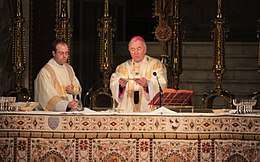Sacrosanctum Concilium
Sacrosanctum Concilium, the Constitution on the Sacred Liturgy, is one of the constitutions of the Second Vatican Council. It was approved by the assembled bishops by a vote of 2,147 to 4 and promulgated by Pope Paul VI on 4 December 1963.[1] The main aim was to achieve greater lay participation in the Catholic Church's liturgy. The title is taken from the opening lines of the document and means "this Sacred Council".

 |
| Part of a series on the |
| Canon law of the Catholic Church |
|---|
|
Jus antiquum (c. 33-1140)
Jus novum (c. 1140-1563) Jus novissimum (c. 1563-1918) Jus codicis (1918-present) Other |
|
Sacraments
Sacred places
Sacred times |
|
|
Supreme authority, particular churches, and canonical structures Supreme authority of the Church
Supra-diocesan/eparchal structures
|
|
|
Temporal goods (property) |
|
Canonical documents |
|
Procedural law Pars statica (tribunals & ministers/parties)
Pars dynamica (trial procedure)
Election of the Roman Pontiff |
|
Legal practice and scholarship
Academic degrees Journals and Professional Societies Faculties of canon law
Canonists |
|
|
Contents
The numbers given correspond to section numbers within the text.
- Introduction (1–4)
- General Principles for the Restoration and Promotion of the Sacred Liturgy (5–46)
- The Nature of the Sacred Liturgy and Its Importance in the Church's Life (5–13)
- The Promotion of Liturgical Instruction and Active Participation (14–20)
- The Reform of the Sacred Liturgy (21–46)
- General Norms (22–25)
- Norms Drawn from the Hierarchic and Communal Nature of the Liturgy (26–32)
- Norms Based Upon the Didactic and Pastoral Nature of the Liturgy (33–36)
- Norms for Adapting the Liturgy to the Culture and Traditions of Peoples (37–40)
- Promotion of Liturgical Life in Diocese and Parish (41–42)
- The Promotion of Pastoral-Liturgical Action (43–46)
- The Most Sacred Mystery of the Eucharist (47–58)
- The Other Sacraments and the Sacramentals (59–82)
- The Divine Office (83–101)
- The Liturgical Year (102–11)
- Sacred Music (112–21)
- Sacred Art and Sacred Furnishings (122–30)
- Appendix: A Declaration of the Second Ecumenical Council of the Vatican on Revision of the Calendar
Title and purpose
As is customary with Catholic documents, the name of this constitution, "Sacred Council" in Latin, is taken from the first line (incipit) of the document:
1. This sacred Council has several aims in view: it desires to impart an ever increasing vigor to the Christian life of the faithful; to adapt more suitably to the needs of our own times those institutions which are subject to change; to foster whatever can promote union among all who believe in Christ; to strengthen whatever can help to call the whole of mankind into the household of the Church. The Council therefore sees particularly cogent reasons for undertaking the reform and promotion of the liturgy.
Participation of the laity
One of the first issues considered by the council, and the matter that had the most immediate effect on the lives of individual Catholics, was the renewal of the liturgy. The central idea was that there ought to be greater lay participation in the liturgy.
Mother Church earnestly desires that all the faithful should be led to that fully conscious and active participation in liturgical celebrations which is demanded by the very nature of the liturgy. Such participation by the Christian people as a chosen race, a royal priesthood, a holy nation, a redeemed people (1 Peter 2:9; cf. 2:4–5), is their right and duty by reason of their baptism.[2]
Popes Pius X,[3] Pius XI,[4] and Pius XII[5] consistently asked that the people be taught how to chant the responses at Mass and that they learn the prayers of the Mass in order to participate intelligently. Now the bishops decreed that: "To promote active participation, the people should be encouraged to take part by means of acclamations, responses, psalmody, antiphons, and songs."[6] Composers should "produce compositions which ... [provide] for the active participation of the entire assembly of the faithful."[7]
After centuries when, with the Mass in Latin, Catholic piety centred around popular devotions, the bishops decreed that "Popular devotions ... should be so drawn up that they harmonize with the liturgical seasons, accord with the sacred liturgy, are in some fashion derived from it, and lead the people to it, since, in fact, the liturgy by its very nature far surpasses any of them."[8]
On 24 August 2017 Pope Francis emphasized that "the reform of the liturgy is irreversible" and called for continued efforts to implement the reforms, repeating what Pope Paul VI had said one year before he died: "The time has come, now, to definitely leave aside the disruptive ferments, equally pernicious in one sense or the other, and to implement fully, according to its right inspiring criteria, the reform approved by us in application of the decisions of the council."[9]
Consilium
The council fathers established guidelines to govern the renewal of the liturgy, which included, allowed, and encouraged greater use of the vernacular (native language) in addition to Latin, particularly for the biblical readings and other prayers. Implementation of the council's directives on the liturgy was to be carried out under the authority of Pope Paul VI by a special papal commission,[10] later incorporated in the Congregation for Divine Worship and the Discipline of the Sacraments, and, in the areas entrusted to them, by national conferences of bishops, which, if they had a shared language, were expected to collaborate in producing a common translation.[11][12]
References
Citations
- "The fortieth anniversary of the Constitution on the Sacred Liturgy, Piero Marini". www.vatican.va. Retrieved 13 February 2018.
- Second Vatican Council 1963, sec. 14.
- "Tra Le Sollecitudini Instruction on Sacred Music – Adoremus Bulletin". Adoremus Bulletin. 22 November 1903. Retrieved 13 February 2018.
- Byrne, Carol. "Dialogue Mass VIII – Pius XI Endorses the Liturgical Revolution – Dr Carol Byrne". www.traditioninaction.org. Retrieved 13 February 2018.
- "Musicae Sacrae (December 25, 1955) | PIUS XII". w2.vatican.va. Retrieved 13 February 2018.
- Second Vatican Council 1963, sec. 30.
- Second Vatican Council 1963, sec. 121.
- Second Vatican Council 1963, sec. 13.
- "Pope Francis Says with Magisterial Authority: The Vatican II Liturgical Reform Is 'Irreversible'". America. 24 August 2017. Retrieved 13 February 2018.
- "The Second Vatican Ecumenical Council – Dedicated to "The Immaculate"". www.christusrex.org. Archived from the original on 15 December 2017. Retrieved 13 February 2018.
- "Sacrosanctum concilium, 36". www.vatican.va. Retrieved 13 February 2018.
- Kappes 2009.
Bibliography
- Kappes, Christiaan W. (2009). The Chronology, Organization, Competencies and Composition of the Consilium ad exsequendam Constitutionem de Sacra Liturgia. Retrieved 22 October 2017.
- Second Vatican Council (1963). Sacrosanctum concilium: Constitution on the Sacred Liturgy. Vatican City: Libreria Editrice Vaticana. Retrieved 22 October 2017.
Further reading
- Amerio, Romano (1996). Iota Unum. Kansas City, Missouri: Sarto House. ISBN 978-0-9639032-1-1.
- Jungmann, Josef Andreas (1966). "Constitution on the Sacred Liturgy". In Vorgrimler, Herbert (ed.). Commentary on the Documents of Vatican II. 1. London: Burns & Oates. pp. 1–80.
- Linden, Ian (2009). Global Catholicism: Diversity and Change since Vatican II. London: Hurst & Co. p. 337.
- Sinke Guimarães, Átila (1997). In the Murky Waters of Vatican II. Metairie, Louisiana: MAETA. ISBN 978-1-889168-06-7.
- Whitehead, Kenneth D., ed. (2009). Sacrosanctum Concilium and the Reform of the Liturgy: Proceedings from the 29th Annual Convention of the Fellowship of Catholic Scholars. Scranton, Pennsylvania: University of Scranton Press.